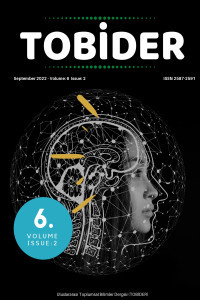ÇEVİRMENİN ÇOKLU HABİTUSU
Çeviri sosyolojisi alanında son dönemde yapılan çalışmalar çeviriyi metnin dışına taşırarak, ilgiyi metnin arkasında yer alan eyleyenlere yöneltmektedir. Özellikle bu alanda eyleyenlere yönelik yapılan çalışmalar; Bourdieu’nün habitus kavramını, çevirmen ve diğer eyleyenlerle ilintilendirmektedir. Sosyal bir eyleyen olarak çevirmenin geçmişin emareleriyle örülü makro kozmosa özgü davranış, tutum ve yatkınlıklarının, çeviri sürecinde vermiş olduğu kararlara yansımalarının analizinde habitus kavramı önemli veriler sunmaktadır. Bu yeni çalışma alanının derin meselelerinden biri çevirmenin sosyo-kültürel kimliğinin tarihsel analizinin yapılması ve eldeki verilerin çeviriye, çevirmen kararlarına yansımalarına bakılmasıdır. Bu çalışmada çevirmenin habitusuna yönelik tarihsel bir analiz yapılacaktır. Sosyal bir eyleyen olarak çevirmen habitusunun makro kozmos (toplum), mikro kozmos (çeviri alanı), mezo kozmos (çevirmenin psikolojisi) ve çoklu kozmos yapılarla olan ilişkisinin analiz edilmesi amaçlanmaktadır. Aynı zamanda çevirmen habitusuna yönelik yapılacak bir gözlem çeviri eyleminin arkasındaki çoklu habitus ilişkilerinin varlığına ayna tutacaktır. Bu çalışmanın bir diğer hedefi ise çeviri eylemine ilişkin bu karmaşık ilişkiler ağının sadece metin üzerinden gidilerek değil, aynı zamanda çevirmenin çoklu habitusunun çoklu tarihsel analizinden elde edilen verilerle, metinle bir ilişki kurulabileceğini göstermeyi amaçlamaktadır. Çevirmen habitusu, çevirmenlerin genetik hikâyelerinde, sosyal gidişatlarında ya da biyografilerinde saptanabileceği gibi, çevirmenin çeviri metni metinselleştirme boyutundan, dilsel ve çeviri tercihlerinde de anlaşılabilir. Çalışmada çevirmen habitusuna ilişkin bir gözlem yapılacaktır. Çevirmen habitusunun izleri makro kozmos düzeyde olduğu gibi mikro kozmos ve mezo kozmos düzeyde de sürülecektir. Bu sayede çevirmenin toplumsallığının çeviri metnin toplumsallığına yansımaları incelenecek, diğer bir deyişle makro kozmos belirlenimlerin mikro kozmos belirlenimlere yansımaları gözlemlenecektir.
Anahtar Kelimeler:
Çevirmen, Habitus, Makro Kozmos, Mikro Kozmos, Mezo Kozmos
TRANSLATOR’S MULTIPLE HABITUS
Recent studies in the field of translation sociology take the translation beyond the text and direct the attention to the actors behind the text. Studies in this field associate Bourdieu’s concept of habitus with the translator and other actors. The concept of habitus provides very important data in the analysis of the reflections of, as a social actor, the translator’s behaviors, attitudes and predispositions which belong to the macrocosm, to the decisions during the translation process. One of the deep issues of this new study field is to make a historical analysis of the socio-cultural identity of the translator and to look at the reflections of the available data on translation and translator decisions. In this study, a historical analysis of the translator’s habitus will be made. It is aimed to analyze the relationship of the translator’s habitus as a social actor with macrocosm (society), microcosm (translation field), mesocosm (translator’s psychology) and multiple cosmos structures. At the same time, an observation on the translator’s habitus will mirror the existence of multiple habitus relations behind the act of translation. Another aim of this study is to show that this complex network of relations related to the act of translation can be associated with the text not only by going through the text, but also by the data obtained from the multiple historical analysis of the translator’s multiple habitus. The translator’s habitus can be determined in the genetic stories, social trajectories or biographies of the translators, as well as in the linguistic and translation preferences of the translator from the textualization dimension of the translation text. In the study, an observation will be made about the translator’s habitus. Traces of the translator’s habitus will be traced at the microcosm and mesocosm level as well as at the macrocosm level. In this way, the reflections of the sociality of the translator on the sociability of the translated text will be examined, in other words, the reflections of macrocosmic determinations to microcosmic determinations will be observed.
Keywords:
Translator, Habitus, Macro Cosmos, Micro Cosmos, Mezo Cozmos,
___
- Bourdieu, P. (1992). The field of cultural production. Essays on art and literature. Randal Johnson, (Trans. and Ed.). Cambridge: Polity Press.
- Bourdieu, P. (2005). Habitus. In habitus: A sense of place. J. Hiller and E. Rooksby (Eds.), (pp.43–49). Aldershot: Ashgate.
- Łepko, Z. (2016). From mesocosmos to cosmos: Man. In Search of His Oikos, 37, 4, (pp. 45-54).
- Meylaerts, R. (2008). Translators and (their) norms. Towards a sociological construction of the individual. Beyond Descriptive Translation Studies. Benjamins Translation Library.
- Raková, Z. (2016). Çeviri kuramları.(Çev. Y.Polat). Ankara.
- Simeoni, D. (1998). The pivotal status of the translator’s habitus. In Target, International Journal of Translation Studies,10(1) (pp. 1-39).
- Vermeer, H. J. (2006). Luhmann’s ‘social systems’ theory: Preliminary fragments for a theory of translation. Berlin: Frank&Timme.
- Xu, M and C, Yu Chu. (2015). Translator’s Professional habitus and the adjacent discipline: The case of Edgar Snow. Target 27: 2, (pp. 173–191).
- Başlangıç: 2017
- Yayıncı: Sadık Hacı
Sayıdaki Diğer Makaleler
UÇ NOKTALAR ARASINDA BİR YOLCULUK: BLACK MIRROR’DA POSTHÜMANİZM TEKNOLOJİLERİNE FELSEFİ BİR BAKIŞ
ALMAN EDEBİYATINDA TANIKLIK EDİLMEYEN TARİHİN KURGULANMASI: MARCEL BEYER ÖRNEĞİNDE
ACIYI HİSSETMEK AMA YİNE DE UMUT ETMEK: KRİZ GAZETECİLİĞİNDE DUYGU VE SÖYLEM
ENERJİ GÜVENLİĞİ BAĞLAMINDA AB ENERJİ POLİTİKALARI ve AB-ORTA ASYA İLİŞKİLERİ
Ferhat Çağrı ARAS, Ekber KANDEMİR
HÂREZMŞAHLAR DEVLETİ’NDE İN’ÂM, İHSAN VE DİĞER HEDİYELER
ERMENİCE HAGİOGRAFİK METİNLERDEKİ İLHANLILARA DAİR KAYITLARIN DEĞERLENDİRİLMESİ
